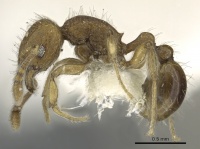Tetramorium difficile
| Tetramorium difficile | |
|---|---|

| |
| Scientific classification | |
| Kingdom: | Animalia |
| Phylum: | Arthropoda |
| Class: | Insecta |
| Order: | Hymenoptera |
| Family: | Formicidae |
| Subfamily: | Myrmicinae |
| Tribe: | Crematogastrini |
| Genus: | Tetramorium |
| Species: | T. difficile |
| Binomial name | |
| Tetramorium difficile Bolton, 1977 | |
The holotype was collected from a forest litter sample.
Identification
A member of the Tetramorium tonganum-species group.
Bolton (1977) - T. difficile shows affinity with Tetramorium tonganum but is smaller than that species and has relatively shorter antennal scapes. Also, the pronotal corners in tonganum are very broadly rounded, whilst those of difficile are more angular (though not sharply so).
A series from Bhutan: Phuntsholing, 1972,2/400 m (Baroni Urbani) in NM, Basle, compares well with the type-series but the individuals are somewhat darker in colour (mid-brown) and in some the propodeal spines are slightly but definitely longer than the metapleural lobes. The metapleural lobes themselves are somewhat more acute than in the types. Despite these (relatively minor) differences I feel sure that this series from Bhutan represents part of the normal variation of difficile.
Distribution
Latitudinal Distribution Pattern
Latitudinal Range: 26.916667° to 21.91863889°.
| North Temperate |
North Subtropical |
Tropical | South Subtropical |
South Temperate |
- Source: AntMaps
Distribution based on Regional Taxon Lists
Oriental Region: Nepal (type locality).
Palaearctic Region: China.
Distribution based on AntMaps
Distribution based on AntWeb specimens
Check data from AntWeb
Countries Occupied
| Number of countries occupied by this species based on AntWiki Regional Taxon Lists. In general, fewer countries occupied indicates a narrower range, while more countries indicates a more widespread species. |

|
Estimated Abundance
| Relative abundance based on number of AntMaps records per species (this species within the purple bar). Fewer records (to the left) indicates a less abundant/encountered species while more records (to the right) indicates more abundant/encountered species. |

|
Biology
Castes
Nomenclature
The following information is derived from Barry Bolton's Online Catalogue of the Ants of the World.
- difficile. Tetramorium difficile Bolton, 1977: 126 (w.) NEPAL.
Unless otherwise noted the text for the remainder of this section is reported from the publication that includes the original description.
Description
Worker
Holotype. TL 2.4, HL 0.56, HW 0.52, CI 93, SL 0.40, SI 77, PW 0.38, AL 0.64.
Mandibles striate; anterior clypeal margin entire and the median portion with a narrow anterior flange or apron. Frontal carinae well developed, reaching back well beyond the level of the eyes and forming the upper borders of the shallow but quite distinct antennal scrobes. Maximum diameter of eye c. 0.12, about 0.23 x HW. Propodeal spines short and dentiform, slightly shorter than the short, bluntly triangular metapleural lobes. Petiole in profile with a slightly downcurved anterior peduncle, the node itself has rounded anterodorsal and posterodorsal angles and the tergal portion is slightly higher than the length of the dorsum. Postpetiole in profile evenly convex. In dorsal view the petiole node is slightly broader than long and the postpetiole is only slightly broader than the petiole. Dorsum of head weakly longitudinally rugulose, with some feeble reticulation occipitally. Dorsal alitrunk finely reticulate-rugulose, the petiole node with faint traces of rugulation dorsally. Post petiole and gaster unsculptured and shining. All dorsal surfaces of head and body with numerous fine hairs of varying length but the scapes and dorsal (outer) surfaces of the hind tibiae only with short, decumbent or appressed pubescence, without longer hairs. Colour uniform yellowish brown.
Paratype. As holotype, TL 2.3, HL 0.54, HW 0.50, CI 93, SL 0.38, SI 76, PW 0.36, AL 0.62. Maximum diameter of eye 0.12, about 0.24 x HW.
Type Material
Holotype worker, NEPAL: Tamur R., Dobhan, l.ii.l962, forest litter (K. Hyatt) (The Natural History Museum). Paratype. 1 worker with same data as holotype (Museum of Comparative Zoology).
References
- Bolton, B. 1977. The ant tribe Tetramoriini (Hymenoptera: Formicidae). The genus Tetramorium Mayr in the Oriental and Indo-Australian regions, and in Australia. Bulletin of the British Museum (Natural History). Entomology. 36:67-151. (page 126, worker described)
- Dendup, K.C., Dorji, C., Dhadwal, T., Bharti, H., Pfeiffer, M. 2021. A preliminary checklist of ants from Bhutan. Asian Myrmecology 14, e014005 (doi:10.20362/am.014005).
- Subedi, I.P., Budha, P.B. 2019. Status of ant research and species first described from Nepal with new distribution records. Journal of Natural History Museum. 31:57-78.
- Subedi, I.P., Budha, P.B., Bharti, H., Alonso, L. 2020. An updated checklist of Nepalese ants (Hymenoptera, Formicidae). ZooKeys 1006, 99–136 (doi:10.3897/zookeys.1006.58808).
References based on Global Ant Biodiversity Informatics
- Bolton B. 1977. The ant tribe Tetramoriini (Hymenoptera: Formicidae). The genus Tetramorium Mayr in the Oriental and Indo-Australian regions, and in Australia. Bulletin of the British Museum (Natural History). Entomology 36:67-151.
- Bolton, B. "The ant tribe Tetramoriini (Hymenoptera: Formicinae. The genus Tetramorium Mayr in the Oriental and Indo-Australian regions and in Australia." Bulletin of the British Museum (National History): Entomology series 36, no. 2 (1977): 68-151.
- Liu C, B. Guénard, F Hita Garcia, S. Yamane, B. Blanchard, and E. Economo. New records of ant species from Yunnan, China. Submitted to Zookeys
- Roncin E. 2002. Two new Tetramorium species (Hymenoptera: Formicidae) from Vietnam with a discussion of the mixtum, tonganum, and scabrosum groups. Sociobiology 40: 281-292.

